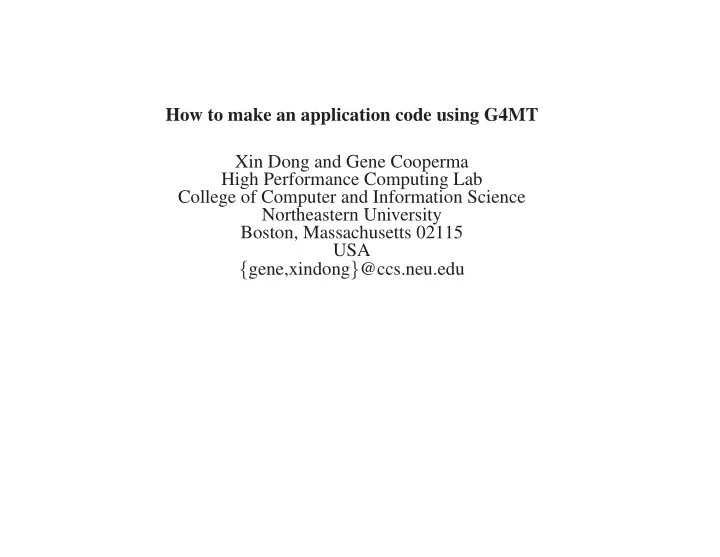

How to make an application code using G4MT Xin Dong and Gene Cooperma High Performance Computing Lab College of Computer and Information Science Northeastern University Boston, Massachusetts 02115 USA { gene,xindong } @ccs.neu.edu
Geant4MT Tools for Implementation Support • Transformation for Thread Safety (TTS) 1. make each global or static variable thread-local 2. independent threads lead to absolute thread-safety: any thread can call any function. No data race! • Transformation for Memory Reduction (TMR) 1. relatively read-only data : written to during its initialization and read- only during the computation of each event. 2. share relatively read-only data, and replicate other data • Debugging Tools 1. compare the original program with the multi-threaded version 2. runtime correctness: to serialize updates to shared data • Malloc Non-standard Extension using a Thread-Private Heap (TPMalloc) • Avoidance of Cache Coherence Bottlenecks
N02 Parallelization: Change List I N02 ParN02 Comments Action exampleN02.cc ParN02.cc Parallel Application Main TMR ParTopC.icc Common Frame Copy mymalloc.h TPMalloc Copy hjmalloc.c TPMalloc Copy mymalloc.c TPMalloc Copy tpmallocstub.h TPMalloc Copy tpmallocstub.c TPMalloc Copy GNUmakefile Link to TPMalloc Copy + Change
N02 Parallelization: Change List II N02/include ParN02/include Comments Action ExN02ChamberParameterisation.hh ExN02DetectorConstruction.hh TMR ExN02DetectorMessenger.hh ExN02EventAction.hh ExN02MagneticField.hh ExN02PhysicsList.hh ExN02PrimaryGeneratorAction.hh ExN02RunAction.hh ExN02SteppingAction.hh ExN02SteppingVerbose.hh ExN02TrackerHit.hh global TTS ExN02TrackerSD.hh G4MycoutDestination.icc TPoutput Copy GetTid.hh TPoutput Copy GetTid.icc TPoutput Copy ParRunManager.hh Common Frame Copy
N02 Parallelization: Change List III N02/src ParN02/src Comments Action ExN02ChamberParameterisation.cc ExN02DetectorConstruction.cc TMR ExN02DetectorMessenger.cc ExN02EventAction.cc ExN02MagneticField.cc ExN02PhysicsList.cc ExN02PrimaryGeneratorAction.cc ExN02RunAction.cc ExN02SteppingAction.cc ExN02SteppingVerbose.cc ExN02TrackerHit.cc global TTS ExN02TrackerSD.cc static TTS ParRunManager.cc Common Frame Copy + Change
Thread Local Storage (TLS): An Example #include < stdio.h > #include < pthread.h > thread int gvar = 0; //int gvar = 0; void *increase(void *) { gvar++; printf(”Value in child thread: %d \ n”, gvar); } int main(int argc, char* argv[]) { pthread t tid; printf(”Value in main thread: %d \ n”, gvar); pthread create( &tid, NULL, increase, NULL ); pthread join(tid, NULL); printf(”Value in main thread: %d \ n”, gvar); return 0; } Value in main thread: 0 Value in child thread: 1 Value in main thread: 0
ExN02TrackerHit.hh Before TTS extern G4Allocator < ExN02TrackerHit > ExN02TrackerHitAllocator; inline void* ExN02TrackerHit::operator new(size t) { void *aHit; aHit = (void *) ExN02TrackerHitAllocator.MallocSingle(); return aHit; } inline void ExN02TrackerHit::operator delete(void *aHit) { ExN02TrackerHitAllocator.FreeSingle((ExN02TrackerHit*) aHit); }
ExN02TrackerHit.hh After TTS extern thread G4Allocator < ExN02TrackerHit > *ExN02TrackerHitAllocator; inline void* ExN02TrackerHit::operator new(size t) { if (!ExN02TrackerHitAllocator) ExN02TrackerHitAllocator = new G4Allocator < ExN02TrackerHit > ; void *aHit; aHit = (void *) (*ExN02TrackerHitAllocator).MallocSingle(); return aHit; } inline void ExN02TrackerHit::operator delete(void *aHit) { if (!ExN02TrackerHitAllocator) ExN02TrackerHitAllocator = new G4Allocator < ExN02TrackerHit > ; (*ExN02TrackerHitAllocator).FreeSingle((ExN02TrackerHit*) aHit); }
TTS for Others ExN02TrackerHit.cc before TTS: G4Allocator < ExN02TrackerHit > ExN02TrackerHitAllocator; ExN02TrackerHit.cc after TTS: thread G4Allocator < ExN02TrackerHit > *ExN02TrackerHitAllocator = 0; ExN02TrackerSD.cc before TTS: static G4int HCID = -1; ExN02TrackerSD.cc after TTS: static thread G4int HCID = -1;
TMR for ExN02DetectorConstruction.hh I
TMR for ExN02DetectorConstruction.hh II
TMR for ExN02DetectorConstruction.cc I thread ExN02MagneticField* ExN02DetectorConstruction::fpMagField = 0; thread ExN02DetectorMessenger* ExN02DetectorConstruction::detectorMessenger = 0; void ExN02DetectorConstruction::SlaveExN02DetectorConstruction() { fpMagField = new ExN02MagneticField(); detectorMessenger = new ExN02DetectorMessenger(this); }
TMR for ExN02DetectorConstruction.cc II ExN02DetectorConstruction::ExN02DetectorConstruction() :solidWorld(0), logicWorld(0), physiWorld(0), solidTarget(0), logicTarget(0), physiTarget(0), solidTracker(0),logicTracker(0),physiTracker(0), solidChamber(0),logicChamber(0),physiChamber(0), TargetMater(0), ChamberMater(0),chamberParam(0), stepLimit(0), fWorldLength(0.), fTargetLength(0.), fTrackerLength(0.), NbOfChambers(0) , ChamberWidth(0.), ChamberSpacing(0.) { fpMagField = new ExN02MagneticField(); detectorMessenger = new ExN02DetectorMessenger(this); }
TMR for ExN02DetectorConstruction.cc III void ExN02DetectorConstruction::SlaveDestroy() { delete fpMagField; delete detectorMessenger; } ExN02DetectorConstruction:: ExN02DetectorConstruction() { delete fpMagField; delete stepLimit; delete chamberParam; delete detectorMessenger; }
TMR for ExN02DetectorConstruction.cc I
TMR for ExN02DetectorConstruction.cc II
TMR for ExN02DetectorConstruction.cc III
TMR for ExN02DetectorConstruction.cc IV
TMR for ExN02DetectorConstruction.cc V
TMR for ExN02DetectorConstruction.cc VI
TMR for ExN02DetectorConstruction.cc VII
TMR for ExN02DetectorConstruction.cc VIII
TMR for ExN02DetectorConstruction.cc IX
TMR for ExN02DetectorConstruction.cc X
TMR for ExN02DetectorConstruction.cc XI G4VPhysicalVolume* ExN02DetectorConstruction::ConstructSlave() { // Sensitive detectors G4SDManager* SDman = G4SDManager::GetSDMpointer(); G4String trackerChamberSDname = ”ExN02/TrackerChamberSD”; ExN02TrackerSD* aTrackerSD = new ExN02TrackerSD( trackerChamberSDname ); SDman- > AddNewDetector( aTrackerSD ); logicChamber- > SetSensitiveDetector( aTrackerSD ); // Visualization attributes G4VisAttributes* BoxVisAtt= new G4VisAttributes(G4Colour(1.0,1.0,1.0)); logicWorld - > SetVisAttributes(BoxVisAtt); logicTarget - > SetVisAttributes(BoxVisAtt); logicTracker- > SetVisAttributes(BoxVisAtt); G4VisAttributes* ChamberVisAtt = new G4VisAttributes(G4Colour(1.0,1.0,0.0)); logicChamber- > SetVisAttributes(ChamberVisAtt);
TMR for ExN02DetectorConstruction.cc XII G4double maxStep = 0.5*ChamberWidth; stepLimit = new G4UserLimits(maxStep); logicTracker- > SetUserLimits(stepLimit); return physiWorld; }
TMR for The Application Main
Questions
Thank You.
Recommend
More recommend